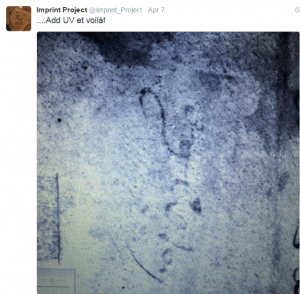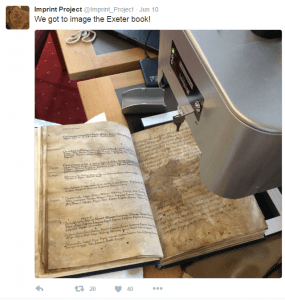If you follow us on Twitter, you will have noticed that when we are on our travels in different archives, we do our best to be as helpful (and, if we’re honest, as nosy) as we can. This means that as well as using our equipment to image seals and helping out by recording conservation issues or repackaging items as we go along, we occasionally try out our equipment on other things, to see if we can recapture anything thought lost, to separate out the colours in the thread used to mend a piece of parchment or just to see what happens. Our Crime-lite Imager, when teamed with our Forensic Light Source, can emit light from the entire spectrum, from Ultra violet to Infra-Red, so can be used to pick up writing which has faded away or to separate out details where there are intermingled materials that fluoresce at different wavelengths, such as plaited cord seal attachments.
When we were in Exeter Cathedral archives, we were very excited to be allowed to use our equipment to have a quick look at the Exeter Book.
i. micel englisc boc be gewhilcum þingum on leoðwisan geworht
‘One large book in English concerning various subjects, composed in verse’
Granted UNESCO status in 2016 when it was added to the Memory of the World register, the Exeter Book is the largest and oldest surviving manuscript of English poetry. Within its 122 folios of statuesque Anglo-Saxon Square Minuscule script, saints’ lives, bestiary texts, maxims, elegies, homiletic texts, and nearly a century of Riddles are inscribed, made all the more incredible by the fact the manuscript was completed by a single scribe. However, despite being the “foundation volume of English literature”, (UNESCO, 2016) for much of its near 1000-year history, the codex has been abused more than used. Having survived for a period of time without a binding, the opening folios of the extant manuscript (ff.8r) have suffered from extensive staining and scoring; a ring-shaped mark (argued to be from a glue pot) sits square in its centre while the edges of the folio are defaced with repeated scoring from a knife, one of which has been crudely sewn back together. These stains affect not one but five folios of the manuscript through to f.13r/v. Forty folios further in, folio 53r/v has been cropped along its top edge, resulting in the loss of 8 lines of manuscript text of Canticles, while the final fourteen folios of the manuscript have suffered from the most significant damage of all: fire damage. This is the result, according to previous editors, of a ‘hot poker or a fire-brand’ being placed across the final folio, burning through the manuscript to f.115r and causing significant textual losses to the final set of Riddles, and a number of short poems (Judgement Day I to Ruin). That flecks of gold and silver can also be seen across a number of folios suggest that the manuscript spent some time being put to practical use in the scriptorium not only as a chopping board (as detailed above) but as a means of keeping gold and silver leaf flat; this repurposing of the codex may well have been key to its survival. Elsewhere, evidence of use rarely pertains to the contents: the manuscript includes a number of drypoint drawings (angels’ heads, vines, some litterae notabiliores, figures holding scrolls, and one – placed upside down on the folio – of a man riding a horse). Research undertaken in the 90s (Conner, 1993) suggests that some of these may have been present on the parchment prior to the manuscript being written, as the ink can be seen to ‘bleed into’ the drypoint lines in a number of places. We used our Crime-lite Imager to image some of these drypoint drawings.

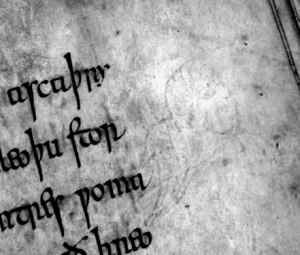
The drypoint sketches were a joy to image. It helped, for a start, that we already knew they were there! Even more exciting for us, however, were the results of our imaging techniques on the text itself. Using various wavelengths of light, we digitally ‘pulled’ text from stains, separated it out from scratches and burn marks. We have given these images to Exeter Cathedral Library and Archives, so that the text can be preserved for future generations. They also raise interesting questions about whether all the stains were, in fact, produced after the manuscript was written.
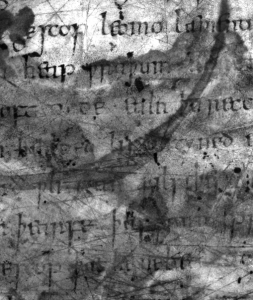
We picked a folio almost at random and found some text that does not, at first glance, have any business being anywhere. Folio 33r has what appears to be one of the litterae notabiliores buried underneath the text, which we brought out for imaging using Infra-Red light from a forensic light source. We thought at first that the text was show-through from the other side, but the other side does not match up. Is part of the Exeter Book a palimpsest, or is something else going on? Either way, this discovery has implications for how we understand the book to have been put together. Is it re-used parchment or did it once have a different order than we now know it?
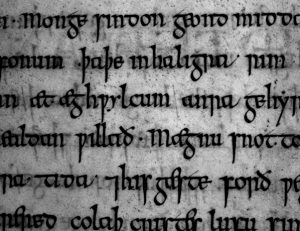
Like all good collaborative projects, we think sharing ideas and skills is vital to scholarship, so Imprint have teamed up with Dr. Johanna Green, a self-confessed Exeter Book obsessive at University of Glasgow. The manuscript has been the centre of her research for over a decade. Often described as a miscellany due to the unusual organisation of contiguous religious and secular texts, a number of more recent studies argue that the manuscript might be better understood as an anthology, within which smaller thematic units of poems can be identified; ‘the Exeter codex is a composite of miniature compositions of which the individual poems can be seen as parts.’ (Lochrie 1986: 323). Johanna’s own research has centred on the decoration and organization of the manuscript’s litterae notabiliores (Green, 2012) which – after extensive examination and analysis – reveals a hierarchical pattern of use that has so far gone relatively unnoticed, but which may indicate certain organisational principles, or visual cues to literacy.
It is clear from the large number of scholarly outputs to date that there is much still to be discovered about the Exeter Book and its contents. Our images taken while having a quick look at the manuscript reveal details not currently visible by the naked eye which may impact how we understand the production of the original manuscript and its use over time. We plan to secure some funding to go back soon and have a proper look at the Exeter Book using our equipment.
The Exeter Book has not given up all its secrets just yet.
Hollie L. S. Morgan and Johanna M. E. Green


